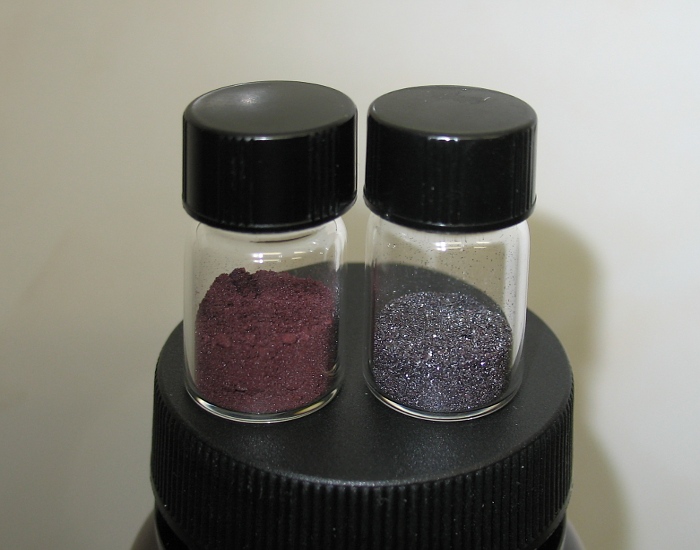


Appearance of red phosphorus
Phosphorus exists in several allotropes. Usually, it is said that there are three allotropes. One well known allotrope is white phosphorus, which is white like wax when pure, but many samples have a somewhat yellow color. Another allotrope of phosphorus is red phosphorus, a fairly dark red/brown amorphous powder. The third (much less known) allotrope is black phosphorus, which is formed from white phosphorus at 12000 atmospheres of pressure and elevated temperatures.
In this experiment it is show that this simple scheme of allotropes is not the whole story. The red allotrope of phosphorus is not a simply entity and it appears that there are many different forms of red phosphorus and maybe there is a whole continuum of allotropes, all considered the red allotrope.
Red phosphorus is oxidized and dissolved, but some solid material remains which cannot easily be oxidized. It is a nearly black solid with a metallic appearance. It is shown that this is phosphorus as well. What allotrope is this?
![]()
![]() Required
chemicals:
Required
chemicals:
-
red phosphorus
-
bleach
-
potassium chlorate
![]() Required
equipment:
Required
equipment:
-
100 ml beaker
-
glass rod
-
petri dish
![]() Safety:
Safety:
- Red phosphorus is flammable.
- Mixtures of red phosphorus and potassium chlorate are very dangerous. Never make more than a few tens of mg of this mixture.
![]() Disposal:
Disposal:
- All involved chemicals are relatively non-toxic and if any solid waste remains, this may be wrapped in a piece of tissue paper and put in the household waste. All liquid waste may be flushed down the drain with a lot of water.
- Bleach should not be flushed into septic tanks, it kills the bacteria in the septic tank.
![]()
Procedure for performing the experiment
![]() Take
approximately 5 grams of red phosphorus and take 50 ml
of bleach. Slowly add some of the red phosphorus and stir vigorously. Most of
the red phosphorus will dissolve and some dark material remains left. The liquid
heats up and some white fumes are formed, which however are not choking or
irritating. A colorless gas is produced as well. The color of the suspension is
brick-red, but after some time it becomes grey or the liquid becomes clear with
some compact material at the bottom.
Take
approximately 5 grams of red phosphorus and take 50 ml
of bleach. Slowly add some of the red phosphorus and stir vigorously. Most of
the red phosphorus will dissolve and some dark material remains left. The liquid
heats up and some white fumes are formed, which however are not choking or
irritating. A colorless gas is produced as well. The color of the suspension is
brick-red, but after some time it becomes grey or the liquid becomes clear with
some compact material at the bottom.
![]() Add more
of the phosphorus while stirring. If the color of the suspension remains red,
then allow the solid material to settle and decant the colorless liquid from the
solid and add a new batch of 50 ml of bleach. With that repeat adding
phosphorus.
Add more
of the phosphorus while stirring. If the color of the suspension remains red,
then allow the solid material to settle and decant the colorless liquid from the
solid and add a new batch of 50 ml of bleach. With that repeat adding
phosphorus.
![]() Quite some bleach may be needed. So, multiple batches of 50
ml may be needed to treat all of the phosphorus.
Quite some bleach may be needed. So, multiple batches of 50
ml may be needed to treat all of the phosphorus.
![]() When all of the phosphorus has been treated, then decant the
liquid from the dark solid and then add another batch of 25 ml of bleach in
order to dissolve final amounts of red phosphorus.
When all of the phosphorus has been treated, then decant the
liquid from the dark solid and then add another batch of 25 ml of bleach in
order to dissolve final amounts of red phosphorus.
![]() Again decant the liquid and rinse the dark solid a few times
with distilled water.
Again decant the liquid and rinse the dark solid a few times
with distilled water.
![]() Decant the distilled water and allow the remaining solid to
dry. A grey somewhat metallic looking crystalline powder remains left.
Decant the distilled water and allow the remaining solid to
dry. A grey somewhat metallic looking crystalline powder remains left.
From 5 grams of red phosphorus I could 'harvest' approximately 300 mg of grey powder. The picture below shows the grey powder, compared with approximately 500 mg of the original red phosphorus.

The yield of grey powder strongly depends on the red phosphorus used. Some brands of red phosphorus leave no or hardly any black residue, while other brands leave quite a lot of black residue.
Result of testing of the grey powder
The grey powder is not some impurity in the red phosphorus, it is phosphorus itself. It is less reactive than red phosphorus in contact with bleach, but at high temperatures or in contact with potassium chlorate it behaves like red phosphorus. Is this the so-called 'violet' allotrope?
When the grey powder is kept in a flame, then it ignites, just like red phosphorus, and it burns calmly with a lot of white smoke, also just like red phosphorus.
When the grey powder is mixed with a small amount of potassium chlorate, then a very sensitive mix is produced. Just tapping the mix with a glass rod leads to explosion of the mix with a lot of smoke and a bright flash of light. This latter experiment must be done with utmost care. Only mix a very small amount of potassium chlorate (not more than 25 mg) with a similar amount of the grey powder. Put the mix in a petri dish and tap the mix with a glass rod.
![]()
Discussion of results
![]() Red phosphorus can be dissolved in bleach. It does, however, react with this and
when it is dissolved, it is converted to phosphoric acid:
Red phosphorus can be dissolved in bleach. It does, however, react with this and
when it is dissolved, it is converted to phosphoric acid:
2P + 5ClO– + 3H2O → 2H3PO4 + 5Cl–
In the alkaline bleach the phosphoric acid partially is neutralized, so the resulting clear liquid will be a solution containing chloride and partially protonated phosphate ions.
Most of the phosphorus quickly reacts with the bleach and quite some heat is produced in the reaction, a small amount of the phosphorus does not dissolve and remains present as a dark grey powder. How much dark grey powder remains depends on the sample of the red phosphorus. Some samples leave behind quite some residue (a few percent of mass), while other samples leave no residue at all. Apparently, red phosphorus is not a precisely specified compound, but it exists in more or less reactive forms.
The colorless gas, produced in the reaction is due to decomposition of bleach when it becomes hot. The reaction between phosphorus and bleach is highly exothermic and the heat of this reaction causes some of the bleach to decompose, giving oxygen and chloride ions.